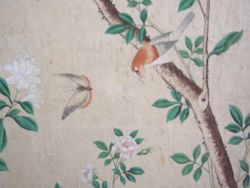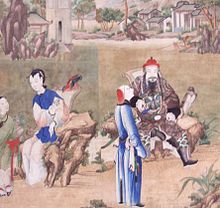Chinese wallpaper
The Chinese wallpaper is the oldest representative of the genre at all and became the model of wallpaper production around the world.
history
Chinese wallpaper originated as early as the Han dynasty . At that time it consisted of lavishly embroidered silk web used by the nobility and the upper classes to cover the walls of their palaces. After the plant fiber paper was invented around 100 AD, paper wallpapers became more and more popular in the 4th century. Since the Chinese bamboo paper is not very tear-resistant, it had to be put on a linen carrier before being used as wallpaper.
During the Song and Yuan periods , paper wallpapers reached their peak. At that time, landscapes in particular came into fashion on wallpapers, while ornamental patterns became increasingly established afterwards in the Ming dynasty .
From the 16th century onwards, Chinese wallpaper came to Europe along with other popular export items. There they still cost about seven times as much as traditional wall coverings in 1760 - the price for a single panel of approx. 365 × 120 cm was roughly the monthly salary of an English country clergyman. Accordingly, Chinese wallpapers were reserved for the nobility for a long time. Quite soon the company began its own production of wallpapers, in Germany in 1638 in Worms and Frankfurt, whereby some “Chinese motifs” were retained, but they were processed relatively freely ( chinoiseries ).
Motifs
While the patterns of European wallpapers developed from textile art, traditional painting was the model for their Chinese counterparts .
An important type is the floral wallpaper, which, following on from the painting traditions of the Tang period , shows flowering trees and bushes populated by birds and insects. The representation was always very naturalistic; the botanist Joseph Banks attested to them around 1771 that they reproduced their subject more accurately than the best botanical authors known to him. Cherry, plum, pomegranate or lychee trees, bamboo, oleander and tea bushes, among the flowers chrysanthemums , hibiscus , hydrangeas and water lilies were often depicted . The bird world is represented by quail, swallows, sparrows, tits, finches, blackbirds, mandarin ducks, partridges, magpies and ravens, but also with more exotic species such as peacock, parrot, cockatoo, kingfisher, oriole or pheasant. There is also a rich variety of butterflies, dragonflies and other insects. As a rule, the individual animals and plants have symbolic power, for example for certain properties, wishes or hopes.
Landscape scenes were also popular. Similar to the ink paintings that serve as a model, a harmonious whole is created from mountains, rivers and lakes, rocks and trees, in harmony with the laws of the cosmos. Humans and the world they have created tend to recede: only occasionally are there a temple, a pagoda , a monastery, a lonely hiker or fisherman. Recognizable inspiration came from the Taoist doctrine, according to which man should submit to nature and not act against its principles.
A third major topic is the everyday life of people, which naturally appeared much more exotic to the European observer than to the Chinese themselves. Scenes from the lives of officials and merchants, the gangs in the markets with traders, customers, beggars and thieves were depicted who have favourited performances by jugglers, acrobats, comedians, singers and fortune tellers. There are also shops, workshops and office rooms, restaurants, tea and wine houses, monasteries and libraries, brothels and prisons. Sometimes the viewer will witness processions, wedding and funeral trains, the New Year , lanterns or autumn moon festival , from officials tests , trials and executions. Often this type of wallpaper also has an instructive and moralizing tendency in that the viewer is shown examples of exemplary child patience or the correct observance of the rites .
Other themes in Chinese wallpaper were historical events , such as the heroic deeds of the generals from the time of the Three Kingdoms , scenes from classic novels and stories such as The Journey to the West as well as fairy tales, myths and legends.
Important Chinese wallpapers in Germany
In the German Wallpaper Museum in Kassel there is a multi-panel wallpaper that depicts a complete funeral procession with soul plaques, medals and coffin bearers, various groups of musicians, Buddhist and Daoist monks, an imperial envoy, as well as girls and prison inmates. Another wallpaper shows a palace scene, there is also a floral wallpaper. A small Sopraporte shows an observed two chickadees mandarin ducks pair. There is also a chinoiserie wallpaper made in Europe , on which "Chinese" customs and rites can be seen.
In addition, there is or was Chinese wallpaper on numerous German castles. Examples include Charlottenburg , Freienwalde , Paretz , Wörlitz , Oranienbaum , Rheinsberg , Oranienburg , the Hallenburg in Schlitz (Vogelsbergkreis) , Hohhaus Palace in Lauterbach (Hesse) , then Werneck , Veitshöchheim , Schwetzingen , Sünching , Munich-Nymphenburg and Wilhelmstal . In the 1990s at Seehof Castle in Memmelsdorf near Bamberg, Chinese specialists reconstructed a silk wallpaper from the 1760s on site using the appropriate materials and techniques on behalf of the State Office for Monument Preservation.
literature
- Friederike Wappenschmidt, Chinese wallpapers for Europe, Berlin 1989, ISBN 3871571369
- Guang Shi Gao, Chinese wallpaper booklet, Gütersloh 1957.




